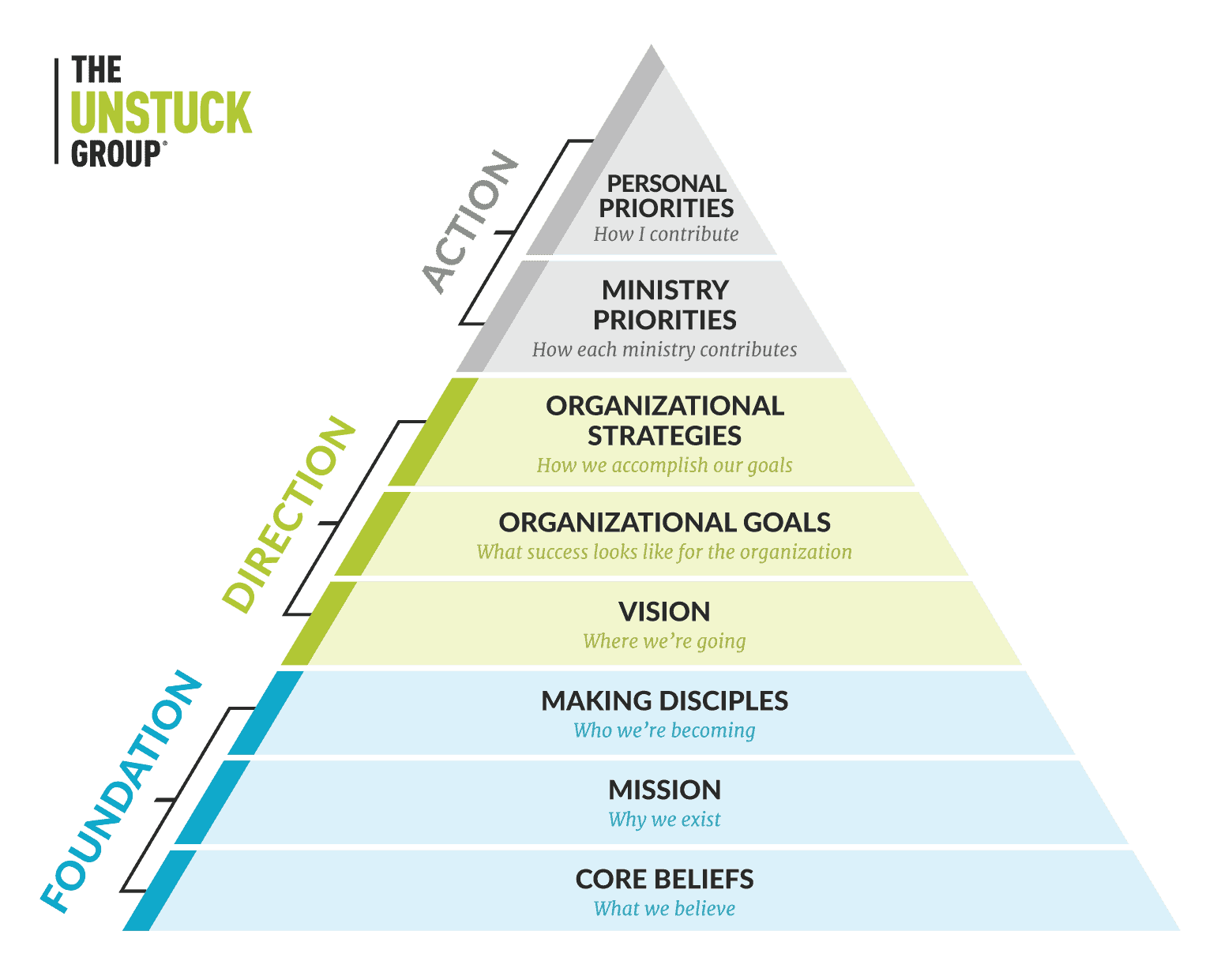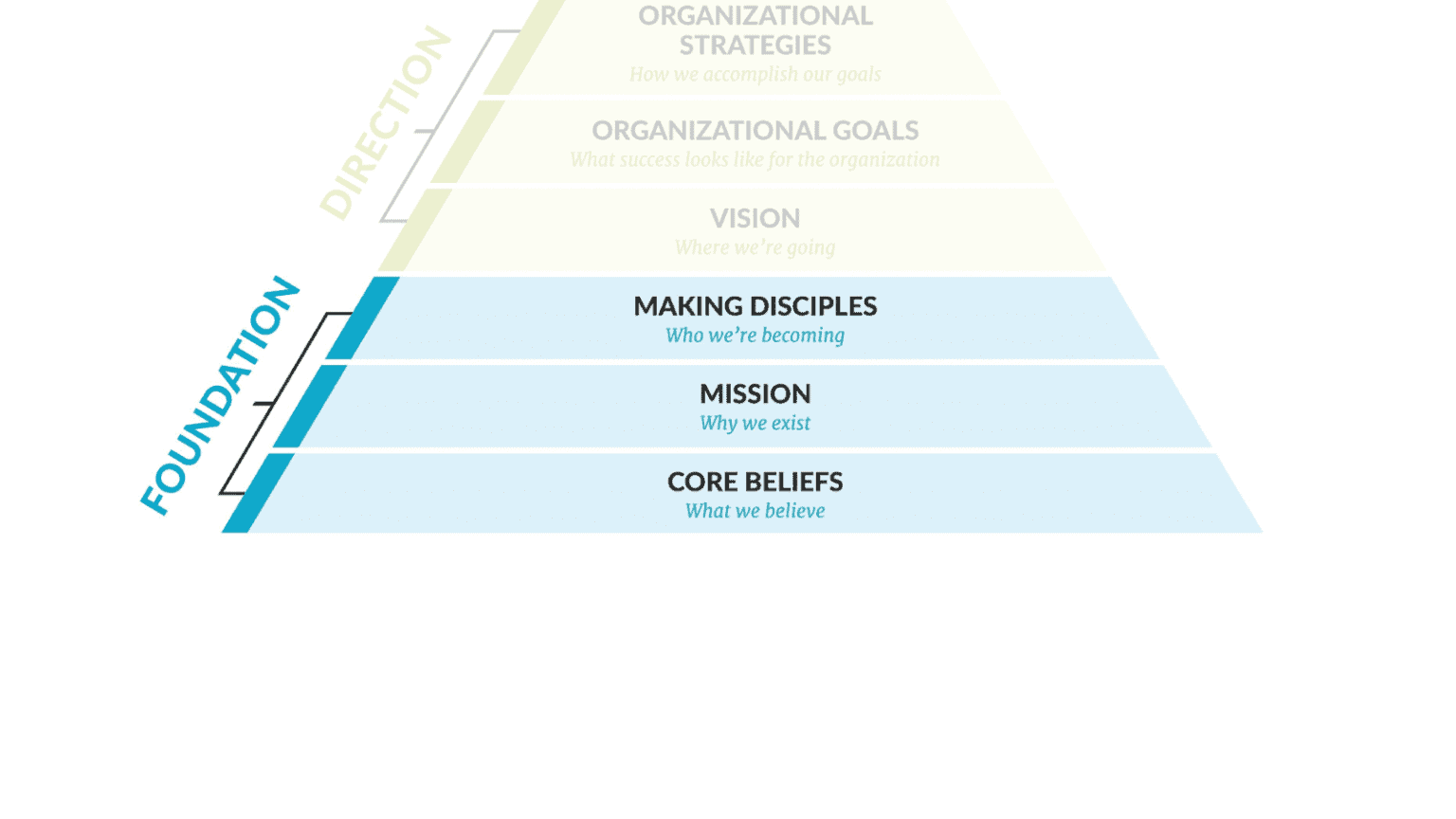Strategic Alignment Pyramid (Part 1)
If you enjoy this episode, subscribe on your device for more:
iTunes RSS Google Play Stitcher Spotify
A few weeks ago we did a webinar called Same Mission, New Strategies (watch the replay), and 1,200+ church leaders joined us for that conversation live. It really seemed to hit a felt need pastors are facing.
How do our methods need to change for the long-term as a result of this disruption our culture has encountered? How do we lead strategic changes while protecting the things that never change?
I wrote about 7 shifts I’m sensing churches need to make, and we also talked about them in Episode 142.
So let’s start getting really practical now.
In this episode, we’re kicking off a 3-part series on a tool we at The Unstuck Group call the Strategic Alignment Pyramid.
Why? Because this is a tool I think many of your churches can use to revisit the foundation of your ministry (why you exist), the direction you’re headed, and the action your teams need to take.
It can help you learn how to reinvent your strategies in a way that will unify your entire team around the mission and the right priorities.

Today, we start with the foundation. In all of this talk about change, we don’t need to change our core beliefs, our mission, or what we believe about making disciples.
But we do need to make sure we’ve clearly defined what we’re about in each level of the foundation BEFORE we go tinkering with strategies.
In this episode, Amy and I discussed…
- Why now is a great time to go back to the foundation—you need to make sure you’ve clearly defined the things that don’t change BEFORE you start changing strategies or roles
- The 3 elements that build the foundation for all of your church’s goals, strategies, structures and systems
- A practical example of clearly articulating what a disciple looks like, and the spiritual formation process (or pathway) in your church, from a real church
- How clarity about the foundation sets you up to lead change more effectively right now
Leader Conversation Guide
Want to take this conversation back to a staff or senior leadership team meeting?
Our Show Notes subscribers get a PDF download that recaps the episode content and includes a discussion guide you can print out and use at an upcoming meeting.
Opt-in here and get the Leader Conversation Guide for this episode, as well as access to the archive.
Let Us Know on Social Media
We use #unstuckchurch on Twitter, and we start a real-time conversation each Wednesday morning when the episode drops. We’d really love to hear from you during this time:
- How can we be praying for you as a lead and your church?
- What stories can you share of ways churches are responding well during this crisis and focusing on opportunities instead of loss?
You can follow me @tonymorganlive and The Unstuck Group @unstuckgroup. If Facebook is where you spend your time, I’m there, too.
Links & Resources from the Episode
- Building Alignment: Clarifying the Direction | Episode 146
- Building Alignment: Action | Episode 147
- How the Unstuck Process Gets Everyone Pulling in the Same Direction
- 7 Shifts Churches Need to Make Because of the Coronavirus
- Coronavirus Response Resources for Pastors
Write a Review—It Helps!
Particularly on iTunes, your ratings and reviews really do help more pastors discover the podcast content I’m creating here. Would you take a minute to share your thoughts? Just open the the podcast on iTunes on your phone or computer, click Ratings & Reviews, and leave your opinion.
Transcript
Amy (00:00): Well, Tony, a few weeks ago we did a webinar called “Same Mission, New Strategies,” and I think we had over 1,200 church leaders join us for that conversation live. It really seemed to hit a felt need that pastors are facing. Can you just recap the heart behind why we teed up that conversation?
Tony (00:16): Yeah, Amy, it really did. The reality is our culture has encountered a major disruption, and I believe it’s creating major shifts in the church world, specifically the seven shifts that we talked about in episode 142 of our podcast. And by the way, if you haven’t listened to that podcast, I encourage listeners to go back and do that. In fact, you may want to push pause on this conversation to go back and listen to that one first. But in the midst of all these shifts, I think many pastors have been asking the wrong question. The question they’ve been asking is when will we be able to get back to doing church the way we used to do church? And by the way, if you want my response to that, it’s going to be a long time before that happens. And because of that, instead we should be asking, how does this disruption need to change our vision, our strategy, and our structure going forward? Now notice I didn’t say we need to change our mission, why we exist as a church. The church has had the same mission since Jesus established the church. But how that mission is lived out has changed, and it will continue to change. So the heart behind that webinar was to get pastors thinking about how vision, strategy and structures need to change in light of our new reality. And not just while churches aren’t able to gather, but what needs to change going forward even when the gatherings are possible again. And I said on the webinar, the church has just been given an amazing permission to reinvent itself. I just believe that is so true, and I’m hoping pastors are courageous enough to seize this time to get relentlessly focused on the strategies that will reach people outside the faith and outside the church. And the strategies that will help all of us look more like Jesus.
Amy (02:15): Yeah. And during our conversation we walked through a tool called the strategic alignment pyramid that visually walked through how pastors can, like in a sense reinvent, think through and realign the work that they and their teams are doing that can help them seize the opportunity. And we had such a response to it, Tony, that I thought we just take the next three weeks to work through the pyramid, talk about it a little bit more in depth, working through each of the sections. And I think that will help pastors learn how to reinvent their strategies in a way that will help their entire team like unify around the work and unifying around the priorities.
Tony (02:50): Yeah. And really, Amy, on that topic, I almost want to jump ahead now to the third week in this podcast because we were just talking about this again this morning is like all three portions of that pyramid that we’re going to talk about are so critical — the foundation, which we’re going to invest in today’s conversation. It’s important. The direction for where the church is heading in the future. I mean that’s a critical part of the conversation we need to have, especially in this season because I do, I believe the direction is going to change. But that third tier of the pyramid that we’re going to talk about has to do with how we align, how we lock arms as a team, and it really puts it into individual responsibilities of what is my role and carrying out the mission, the vision, the direction of our church? It really personalizes it to make sure everybody’s pulling in the same direction. And you know, Amy, I’m all about the results, and so let’s just skip the first two conversations because I want to help teams put it all into action. But we’ll get to that in a few weeks.
Amy (04:05): We’ll get there. Hey, really quick before we jump into where we’re going with this. If you subscribe to our show notes, you’ll be able to download the PDF of the pyramid so that you can kind of track along during these next three podcasts, if that’s helpful. And you can subscribe to the show notes on our webpage anytime. So all right, with that, Tony, let’s dive in. Let’s talk about that foundational level.
Tony (04:27): Yeah. So at the bottom of the pyramid, you’ll see there are three layers that we think make up the foundation of the section and these layers, they just need to be defined. And they really don’t change, which may be actually helpful for you to recognize even in this season where it feels like a lot of change needs to happen in our churches. We just want to encourage you. You need to get the answers to these foundational questions, and really this should be the foundation. I guess it’s kind of like a house. When we update our homes to stay relevant and current, we may remodel the rooms and we could do some new design work, but rarely do we rip up the foundation of our homes. And that’s the same thing we’re going to be talking about in this conversation today for churches beginning with the first level, which is about the core beliefs. What do we believe as people of Christ and collectively as a body of Christ? And at the foundation of this pyramid are the church’s core beliefs. And Amy, I’ve heard, even at your church, describe kind of these three different categories of beliefs. The first one being the beliefs that we die for. These are the beliefs that really the Bible, the word of God, is crystal clear on these things. Like who is God the father? Who’s Jesus? Who’s the Holy Spirit? Beliefs about salvation, beliefs about the Bible itself and the word of God, and beliefs about Christ’s return, as an example. Then there’s these second level of beliefs, and this is the stuff really, honestly, even I start to tune out on some of these things, but I know some of you are really passionate. Like, some of you are strong in your Calvinist convictions. And I know because you’ve shared them with me, and you’ve probably seen my eyes gloss over when you’ve done that. But I know for some of you, you really have strong opinions on some of these theological questions. And Amy, what’s the label that you have? You kind of called these…
Amy (06:46): I call them the defense beliefs. So you covered the die for. These are we defend. We’ve got a position on it. The Bible has something to say about it, but often there’s a theologian who could probably defend an opposite position or a different position because the Bible just isn’t crystal clear. And then the third one of course, is the discussed beliefs, right?
Tony (07:06): Yeah. And those are the ones that really, I think we, most of us, would have question about what does this really mean from scripture? Because even scripture is not completely crystal clear on these. So the key thing in this conversation is there’s these three levels of belief maybe. And where we need to have united conviction is in that first part, those die for beliefs, those core beliefs as a church. And, this may sound like no, would we really ever do this? But I’ve actually seen churches that hired people to be on staff where there wasn’t alignment around core beliefs. And needless to say, that that can create a disruption on the staff team within leadership. And then eventually that can carry out to the rest of the congregation. It would sound obvious, but as churches, we need to have alignment around their core beliefs. And Amy, as I mentioned earlier, those aren’t going to change. Those are going to stay the same probably forever.
Amy (08:18): Well, and hopefully that’s an easy foundational level to start at, a good start on the pyramid, because I think most churches do already have that clarified. So let’s move on to the next level. Level two.
Tony (08:29): Yeah. Level two is all about the mission. It’s the why we exist. And I’ve often shared, in fact, I just had this conversation with a church this past week. Sometimes we get confused about the word mission and vision and goals and things like that. The key thing here is we need to answer that question: Why do we exist? And that’s what the second layer is all about, about the church’s mission. And it answers the question why we exist? What’s our purpose as a church? And again, most churches, they’ve, in most cases, already worked through this. And while churches often have their own version of a mission statement that captures the mission for why the church exists, that mission really was established for us in the New Testament church. And it’s essentially the same across every church that we work with. It’s really about pointing people to Jesus and encouraging people to take their next steps and encouraging people to live out that mission in their lives and then collectively as a body of Christ. But we know it as the great commission from scripture. It’s go and make disciples of all the nations, baptizing them in the name of the Father and the Son and the Holy Spirit. Teach these new disciples to obey all the commands I have given you and be sure of this. I am with you always, even to the end of the age. And if you want to know what motivates Tony Morgan to do what he does, that’s it. God’s called me to personally to that mission as well. And again, this is a key foundational layer that we talk about in this strategic alignment pyramid at The Unstuck Group. And the mission is probably never going to change in your churches, but you have to clarify that mission so that everybody is pulling in the same direction.
Amy (10:30): You know, as you read the great commission, the end of it, I am with you always, even to the end of the age. I just hope our pastors know that God is with us. Even in the midst of this pandemic.
Tony (10:39): We need that reminder, don’t we, Amy?
Amy (10:41): We do. Yeah. All right, great. And the last layer in the foundational level here?
Tony (10:46): It’s about making disciples, making disciples of Jesus. And it defines who we all are becoming or should be becoming as we live out the mission of the church and as we follow Jesus together. And building off of that last level that we talked about related to the mission statement, if we’re truly making new disciples as a church, then we should see people, including ourselves, becoming more like Jesus. And the action in this level of the strategic alignment pyramid is to define what you believe followers of Jesus should look like. And Amy, you know this, this is a conversation that we have with every church that we work with because it’s a personal conviction. I don’t want churches just to gather more people. I want them to help more people become like Jesus. And because of that, we have to define what a disciple of Jesus looks like. And then we help churches clarify their discipleship path. What does that spiritual process look like in your church? So there’s a clear pathway that gives every person an opportunity to take a next step that will best lead them to becoming a person who looks like Jesus.
Amy (12:07): Yeah, we talk about discipleship pathway a lot, but I know when I work with churches, it’s always, it’s a big discussion. They’re anxious to get to that conversation. So I’m wondering, Tony, can you just give us an example of this?
Tony (12:20): Yeah, actually a church I was recently working with worked through this conversation with them. And first we talked about what a disciple of Jesus looks like. And we created a long list of descriptions. I actually like to encourage teams to when you go through this conversation, bring your Bibles with you and make sure that you have some scripture to support the answer to your question here. But the team developed this list. Here are some examples. A disciple of Jesus engages scripture. They don’t just read scripture, they engage scripture in the spiritual practice of prayer. A disciple of Jesus is others-focused. So they sacrifice their needs for others. They share their faith. They realize it’s not just for me but again, the great commission calls me to reach new disciples, make new disciples. They abide in Jesus. They’re in relationship with other believers, so they’re being mentored and they’re mentoring others. Or they’re being discipled and they’re discipling others. Depending on how you talk about that. And then the group indicated we’re understanding God’s story and our roles in that story. And specifically here they talked about identifying spiritual gifts and using those gifts to serve others and to serve within the body of Christ. So, you know, I could give you a lot of different descriptions there but I just think it’s good to begin the conversation about helping people become like Jesus, to understand what’s the goal? What does it look like to become like Jesus? And so it was helpful for this team, and I think it will be your team as well, to actually try to figure out what does the end result look like? What is every bit of our ministry strategy and more specifically our discipleship strategy need to accomplish? From there then, we started talking about the pathway itself and what would lead people who are disconnected from the church and the faith to a place where they’re putting their trust in Jesus and becoming more like him? And this church said, if we want people to become like Jesus, then we should see people receiving God’s grace and extending it to other people. We should see people serving within the body and using the gifts God’s given them. We should see people serving other people outside the church and being generous with their time and their financial resources, and then we should see people connecting to other believers and doing life together in smaller communities. And now that that pathway has been defined, it’s really clear this is what we should be doing as a church to help people take their next steps toward Christ. And again, Amy, we call it a strategic alignment pyramid because we want every individual, everybody on the team, to be pulling in the same direction. And it should be obvious, but many times it’s just not clear in the churches that we’re engaging with. This is our intentional discipleship strategy to encourage that type of growth spiritually so that people who connect to our churches are actually becoming more like Jesus.
Amy (15:52): Yeah, and I love the description of that level on the discipleship path, phrased as who we are becoming, because let’s be honest, we never really arrive. None of us actually get to fully look like Jesus, but we want to be becoming people who look more like Jesus.
Tony (16:08): That’s right. It really does provide clarity to your team and in everything you do, it’s to help people in the church take their next steps toward Christ.
Amy (16:17): All right, well, those were the first three levels and they make up this foundational section of the strategic alignment pyramid. Is there anything else you want to add about this section?
Tony (16:26): Yeah. What’s distinct about this level again, is that it’s foundational. It’s a foundational level for everything else that you do as a church, and it doesn’t change. How you phrase them might get wordsmithed over time. You may adjust how you talk about them in some ways, but regardless of the methods of ministry you engage in the other parts of the pyramid we’re going to be talking about and upcoming weeks, you’re not going to change what you believe. You’re not going to change as a church why you exist, and you’re not going to change the way that you’re helping people become disciples of Jesus Christ. All of that. It’s foundational and it doesn’t change.
Amy (17:11): Yep. Well next week we are going to talk through the next section of the pyramid. Not the top yet, Tony, but the next section, the directional section, which I actually love the most. And if you’re a senior leader at your church, you really don’t want to miss this, especially in the new season of digital ministry. This is where every church, I believe, Tony, should be spending their energy right now to make sure your church doesn’t miss the opportunity that this whole crisis has given us to reach new people and make new disciples. And unlike the foundational level, what we just talked about, right? In the digital world, none of what we just talked about changed. But the methods are going to have to change. And so the directional section, as we talk through it, you’ll notice it should change and probably more than ever needs to change right now. So that’ll be next week. But Tony, before we conclude, any final thoughts as we wrap up today’s conversation?
Tony (18:01): Of course, I have final thoughts, Amy. And first, everything you said, it’s just spot on, and next week’s podcast is going to bring clarity to the new things every church should be thinking about right now as it relates to vision. Where has God calling your church into the future? Your goals, what does success look like for your organization, especially coming out of the season that we’re all experiencing? And then maybe most importantly with regard to the season we’re in as churches, it’s about your strategy too. How will you accomplish your goals and ultimately your vision that God’s called you to as churches? But before we close, I want to speak to those churches that do not have the foundational levels defined for your church. This is where you need to start. Nobody builds a pyramid or a house or a church from the top down. It just doesn’t work that way. You have to build from the bottom up, and to be ready for this next section that we’re going to talk about next week, this hard work needs to get done first. If you don’t have a pathway defined, work with your team to talk through those key next steps you want people in your church to take so that they are best set up to look more like Jesus. And notice I said steps, not events, not programs. Events and programs are strategies to help them take a step, which we’ll talk about next week. For now, identify those three to five steps, no more, that define what people should be doing in order to become more like Jesus. And if you need help working on this, we’d love to start that conversation with you today.






